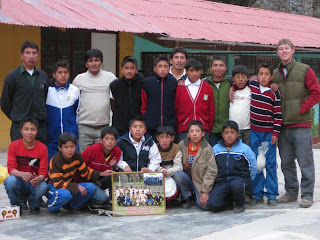Since my last update I’ve been in my site, Tomas, running around like a madman doing a variety of environmental work, doing Peace Corps required reports and documents, and getting things ready to my replacement PCV. Throughout all this I’m making sure to leave time to enjoy a lunch with friends, visit some “relatives”, and celebrate my town’s 77th anniversary. Let me tell you a little about it.
Work recently has been going very well. We’ve made a few minor adjustments to our waste collection system, including acquiring and painting 6 cylinders (or trash cans, as we might say in English) to place in various places around Tomas which seems to be helping keep the streets a little cleaner. I’ve been coordinating things with my students who participating in the provincial science fair, where we won first prize, and are now headed to the entire Lima Region contest on the 29th of October. I’m really proud of my students who’ve learned a lot and put in many hours of work to be able to go to this science fair.
Then comes my town’s anniversary party. The 16th marked the 77th anniversary of the political creation of my town. We celebrated by having a traditional dance contest, soccer and volleyball tournaments, lots of food and a dance. This year, I participated in both the soccer tournament and the traditional dances. My group, which did a Peruvian costal dance about the harvest of sugar cane, won second prize. Below are a few pictures! My soccer team got third.
During the opening ceremony of the anniversary party, I was honored for the work I’ve done in Tomas. I was invited to sit with the Mayor and Governor of my town, and a teacher gave a short speech about the work I’ve done and the affect I’ve had on Tomas. I also gave a short speech, thanking my town for being so accepting and teaching me so much, and every gave a long applause as I sat down. It was very reassuring of the success I feel I’ve had in Tomas. It almost brought me to tears, feeling so supported and wanted by such a small, close knit community.
Right now I’m in Lima to give a training session to the environment trainees about pasture management and municipal waste management. I’m excited to meet the new group, and especially to make some guesses as to who is going to be my replacement in Tomas. I’ll let you know how things work out.
That is all for now. I’ll be home soon!
Peace,
Jared















 Our community Micro Landfill, before being used.
Our community Micro Landfill, before being used.




































